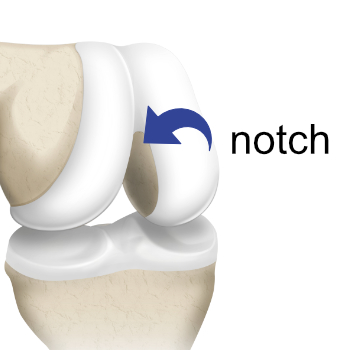A notchplasty is a surgical widening of the intercondylar notch, usually performed as part of an anterior cruciate ligament revision to limit trauma to the reconstructed ligament.
 Page updated March 2024 by Dr Sheila Strover (Clinical Editor)
Page updated March 2024 by Dr Sheila Strover (Clinical Editor)

The roof of the notch may cause impingement problems after anterior cruciate ligament reconstruction.
Is notchplasty indicated for the first ACL reconstruction?
Notchplasty is usually reserved for anterior cruciate ligament reconstruction 'revision' rather than being part of the original reconstruction procedure. It would be indicated where bony spurs form at the abraded edges, causing interference with extension, and shredding the original graft to create a 'cyclops lesion'.
This is because notchplasty itself is not without its own complications.
Quotes from peer-reviewed paper:
-
[A surgeon needs to be]...."aware of potential complications following notchplasty during [anterior cruciate ligament reconstruction] before deciding to perform notchplasty in primary cases....[and] reserving it for the surgical management of arthrofibrosis, treatment of notch osteophytosis and revision ACLR."
Citation: Ranuccio F, Familiari F, Tedesco G, La Camera F, Gasparini G. Effects of Notchplasty on Anterior Cruciate Ligament Reconstruction: A Systematic Review. Joints. 2017 Aug 8;5(3):173-179. doi: 10.1055/s-0037-1605551. PMID: 29270549; PMCID: PMC5738469.
How is notchplasty performed?
A small osteotome (like a chisel), the rotating burr of a 'shaver' instrument or a radiofrequency diathermy device may all be used to abrade the lateral side of the notch to widen it.
The surgeon will take care to remove all debris, which could otherwise cause later problems.
Complications of notchplasty
The most important immediate complications is bleeding (haemarthrosis) from the abraded bone surface or the tunnels made to accommodate the graft in the bone, which bleeding is usually evident immediately after the tourniquet has been released after surgery.
The surgeon may attempt to stop the bleeders, or the team may decide to rely upon compression bandaging and drains.
Later complications may include some biomechanical instability, formation of bony outgrowths (osteophytes) on the edge of the abraded surface and soft tissue adhesions on the new ligament.
Quotes from peer-reviewed paper:
-
....the main cause of hemarthrosis is cancellous bone bleeding from bone tunnels.....Therefore, optimal tunnel width and tight fit of the graft in the tunnel may prevent postoperative hemarthrosis...."
Citation: Çimen O, Azboy I, Cengiz B, Çavuş M, Karaoglu S. Is Intraoperative Bleeding Control Useful After Tourniquet Release in Arthroscopic Anterior Cruciate Ligament Reconstruction? Cureus. 2023 Aug 28;15(8):e44253. doi: 10.7759/cureus.44253. PMID: 37772246; PMCID: PMC10525920.
-
....Aggressive intercondylar notchplasty may cause notch regrowth, as well as articular cartilage histopathologic changes, consistent with early degenerative arthrosis....."
Citation: Kitridis D, Tsifountoudis I, Georgiannos D, Tsikopoulos K, Givissis P, Bisbinas I. Does Bone Regrow After Notchplasty in ACL Reconstruction? A Prospective Computed Tomography Study With 2-Year Follow-up. Orthop J Sports Med. 2021 Sep 8;9(9):23259671211029228. doi: 10.1177/23259671211029228. PMID: 34527755; PMCID: PMC8435929.
Also relevant -
From the Experts -
- Expert view - 2008 - ACL reconstruction failure and revisions - by Dr Frank R Noyes (Knee Surgeon)